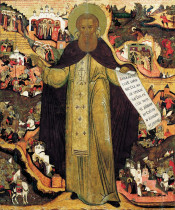
Unique publications about St. Sergius of Radonezh are presented in the Presidential Library
May 3, 2018 marks the 704th anniversary of the birth of Sergius of Radonezh - the ascetic of the Russian land, one of the most revered saints. The Presidential Library's collections include a large number of materials dedicated to the Reverend and tell about his activities for the benefit of the Fatherland.
The future great ascetic was born in 1314. At the christening, the boy was called Bartholomew. John Morev described in detail his childhood and youth in his work "St. Sergius of Radonezh, the great ascetic and conqueror of the Russian land" of 1893. He says: "The more the boy Bartholomew grew, the more clearly his special spiritual qualities revealed; more and more often his extraordinary heart drives and desires affected. As a boy, he was not like other children. So, he completely shied away from children's games and amusements, avoided jokes, laughter and idle talk. But especially he surprised his parents with his fast and abstinence".
Even in his youth in the soul of Bartholomew a desire to devote himself to monastic life arose and became stronger. It was possible to do this only after reaching the age of 23, after the death of the parents. Then the young man retired to the cell and took the monastic vows under the name of Sergius. The newspaper “Tambov Provincial Gazette” in September 1892 wrote: "The relics of St. Sergius are one of the best pages of Christian asceticism. Lonely among the dense forest filled with wolves and bears, devoid of the most necessary food, deepened in the study of the Holy Scripture, contemplative life and prayer, reached by asceticism to wisdom and clairvoyance, the monk soon began to read in the hearts of men, as in an open book". The glory of him quickly spread, people were drawn to Sergius.
"People who wanted to have an example and guidance in spiritual living heard about the holy life of Sergius, began to ask permission to settle and live near it", - we read in the rare book "Memory of the 500th anniversary of the Monk and God-Bearer of our Sergius of Radonezh and All Russia, the Wonderer" – According to the word of the Reverend, the aliens began to build their own huts near a secluded cell, accepting for himself the pattern of his post-natal life".
On the pages of the "Tambov Provincial Gazette" you can find such a remark about the holy: "The Monk Sergei was distinguished by his extraordinary physical strength. His contemporary, pupil and first biographer says: "St. Sergius had strength against two people". It's not for nothing that the ancient saying folded: "In a healthy body - a healthy mind". St. Sergius not only avoided physical labor, but with his own hands cut down all the monastery buildings and the first monastery church, in which he was trimmed into monastic life on October 7, 1342".
"Who was the Reverend Sergius for our Russian Church, for the Russian state, for the Russian people?" - asks Archbishop Nikon in the preface to his work "The Life and Deeds of the Monk and God-Bearer of Our Sergius, Hegumen of Radonezh and All Russia, the Wonderer", 1904 . And he answers: "The Holy Church characterizes it, calling it the pillar of the Church. He was not only himself a strong pillar of the Church of Christ, but, in the words of one of our archpastors, Kherson Archbishop Nikanor, "likened and continues to liken his spiritual nature and all people close to him. He nourished with his strong spirit whole hosts, entire generations of monastics. Up to 70 monasteries were founded by his disciples and pupils of his disciples; his spiritual offspring was one of the main spiritual forces that contributed to the spiritual implementation of different semi-tribal tribes, spread over the space of northern and central Russia, into one whole Great Russian tribe united and animated, fastened by the spirit of Orthodoxy".
The Presidential Library as a center for storing documents on the history of Russian statehood pays much attention to materials that tell about the history of the Russian Orthodox Church. Readers can access unique publications - Ostromir Gospel, Eleazar Gospel, rare books about the spiritual exploits of Alexander Nevsky, John of Kronstadt and other saints in electronic form. A lot of work is under way to digitize the archives of the Alexander Nevsky Lavra, the Alexander-Svirsky Monastery, the documents of the Holy Synod, which from 1837 to 1917 was located in the building where the Presidential Library is housed today.

